Possessing a broad range of appealing and magnificent landscapes, Northeast Vietnam will be an unforgettable choice for visitors on their vacation itinerary. Besides, coming to Northeast, visitors also have opportunities to experience various unique cultural activities, enjoy great dishes or release their emotions. This travel guide about Northeast Vietnam will provide the most crucial instructions so that you will have a meaningful and memorable trip.
In the first part of this travel guide about Northeast of Vietnam, you will be offered basic knowledge about typical features of Northeast. In the rest part of this article, we will introduce you a list of destinations in Northeast Vietnam that you should not miss. A useful tip for visitors is that, you should contact a reliable travel agency so that you will be supported detailed schedule which is suitable with your trip and budget.
Geographical characteristics
Geographical characteristic is one of travelers’ concerns in this travel guide about Northeast Vietnam. Northeast of Vietnam is a part of the North East, including part of the northern coastal plain (Quang Ninh, Haiphong), the mountainous and midland regions in the east of Tam Dao Range. This region has 7 provinces: Ha Giang, Tuyen Quang, Thai Nguyen, Bac Kan, Cao Bang, Lang Son and Quang Ninh. Among these provinces, there are four provinces sharing the border with China, which are Ha Giang, Cao Bang, Lang Son and Quang Ninh.
Northeast is a majestic mountain complex with diverse terrain types. Its terrain is characterized by intense and hierarchical features with many high passes and abysses combined with rift valleys and waterfalls, creating many beautiful landscapes. Beside that are terraced fields and rocky mountains, which are great masterpieces. This is an ideal condition for development of tourist sites. In addition, northeast of Vietnam has cultural identity of ethnic groups in mountainous area, represented by festivals, villages, historical and cultural relics. Furthermore, this region has historical revolutionary system associated with Uncle Ho and People’s Revolutionary Party during the war against French colonialism.
Climate
Depending on climate features that this travel guide about Northeast of Vietnam will supply below, tourists may have appropriate choices. Due to geographical features, the temperature of northeast is rather low in winter due to the impact of cold intrusion, but not too high in the summer due to the mountainous terrain in the north and the sea in the south. The average annual temperature fluctuates between 22 and 23 degrees Celsius. There is a large difference in temperature between seasons in northeast, temperatures are lowest in three months: December, January, February with values ranging from 13 to 18 degrees Celsius. On the other hand, the highest temperature is measured between June and August with a temperature ranging from 26 to 29 degrees Celsius.
Ideal time to visit
One of the most important information in this travel guide about Northeast Vietnam is the best time to visit. If you come to northeast in the spring, you will have opportunities to participate in a wide variety of New Year holidays. Obviously, you will have an enjoyable experience when you are immersed in the village culture of local people here. Besides, if you want to take nice photos of buckwheat flowers brightening plateaus, you should travel in November. This is time when buckwheat flowers are blooming, you will be ecstatic with the road covered with beautiful flower carpets. Or if you are impressed by paddy fields of Hoang Su Phi and Xin Man, then it will be better for you to come in September. Another great option for tourists is taking your trip in the summer, from March to June. Because at this time, it is very dry, which is convenient for sightseeing activities. You should not travel from July to October, for the reason that, this is rainy season, this region is very mountainous, it is highly likely that there are floods and landslides.
Population
Northeast is the living place of many ethnic minorities, these ethnic groups have still retained their unique traditional culture. Each ethnic group has its own cultural heritage, making unique characteristics of this land.
In the second section of this travel guide about Northeast of Vietnam, we will propose a list of common attractions tourists should spend time to discover.
1) Thai Nguyen
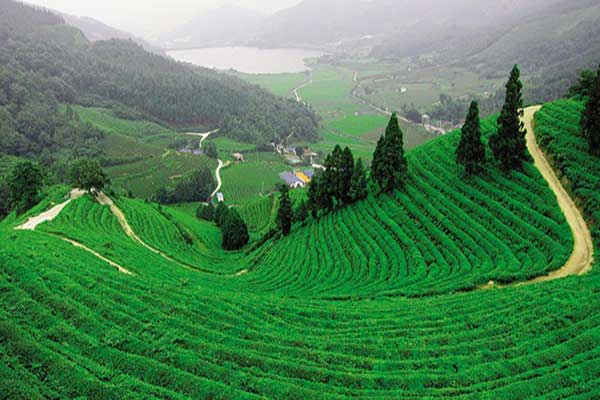
The first destination in this travel guide about Northeast of Vietnam that we want to introduce is Thai Nguyen. Thai Nguyen is a province in the midland and mountainous area of North Vietnam. It borders Bac Kan province in the north, Vinh Phuc province in the west, Tuyen Quang province in the east, Lang Son province in the east and Bac Giang province in the south.
You can make the journey discover to conquer the land of tea in all seasons of the year. But spring and summer are ideal options. Especially in spring, Thai Nguyen has held many sacred festivals in temples and pagodas. This will be a rare opportunity for you to understand rich cultural traditions and spiritual beliefs of a new land. In addition, hot summer is a great time for you to comfortably wave under the cool water of beautiful wild waterfalls.
Thai Nguyen tourism is not only impress tourists by the wide spread of tea fields, but also by the natural scenery that visitors can admire. Attractive destinations cannot be overlooked when travelers come to Thai Nguyen are Tan Cuong tea hill, Nui Coc Lake, Phuong Hoang Cave and Mo Ga Stream, Duom Temple, Vai Mieu Lake and Nam Rut Waterfall, …
Tan Cuong tea hill is not only famous for good tea products but also popular for beautiful natural sceneries and romantic rivers and mountains. Additionally, you can visit Nui Coc Lake, which is well known for the myth of a failed love. Standing in front of the lake, visitors can feel immensity of this lake and vastness of land and sky. Here, you may experience many exciting activities such as visiting fairy parks, zoos, playing in the water park, enjoying fresh seafood caught at the lake. Furthermore, Phuong Hoang Cave and Mo Ga Stream are beautiful landscape populations. After walking to discover Phuong Hoang cave, Mo Ga stream which is at the foot of the mountain is an ideal place for you to rest and relax. Besides, a familiar spiritual tourist destination of local people is Duom temple, which is worshiping a talented general of the Ly dynasty. For Thai Nguyen tourists, Duom Temple is also fascinated by the ancient beauty and surrounding landscapes. Additionally, tourists can discover charming islands, wild and majestic landscapes at Vai Mieu Lake. This is a spot that many visitors are fond of. Or you can contemplate white streams erupted into the river. Moreover, there are many ethnic groups resulting in the diversity of culture and unique festivals. You should not ignore this chance to take part in these special and featured festivals.
2) Ha Long
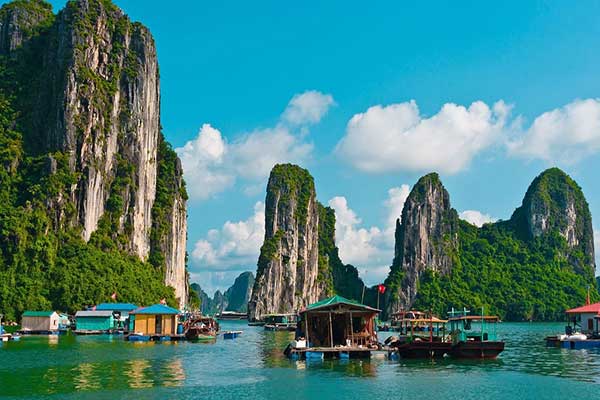
Ha Long is a famous tourist destination of Vietnam, which is considered as a water painting of nature. Ha Long is located in the North, so it will have a typical climate of four seasons. The rainy season usually occurs during the summer months from June to August, the weather is cooler in the period between September and November; then it is cold from around after December.
Normally, when referring to Ha Long, Quang Ninh, people often think of Halong Bay – a natural wonder of the world, Bai Chay or Tuan Chau. But in recent times, the name Bai Tu Long Bay emerged as a new factor for tourists. Additionally, Ha Long tourism has attracted many tourists by a lot of destinations. This travel guide about Northeast of Vietnam will list several options for travelers to choose. Located in the southern part of Ha Long Bay, Lan Ha Bay has just been discovered recently.
In addition, tourists can bathe in the sea at Soi Sim Island, Tuan Chau Island, Co To Island, Bai Dong Island, Quan Lan, Cat Ba and Bai Chay beach, … Besides, tourists may have opportunities to admire the most magnificent caves in Ha Long, which are: Sung Sot Cave (Surprising Cave); Dau Go Cave; Luon Cave; Thien Canh Son Cave; Thien Cung Grotto; … If you want to visit coastal fishing villages, then Cua Van fishing village; Vung Vieng fishing village and Ba Hang fishing village will be great suggestions.
Or, tourists can view Ha Long from above by visiting Bai Tho Mountain, Queen Cable Car at Sun World Halong Complex, … And on the occasions, that tourists are interested in spiritual tourism, then you should not miss Ba Vang pagoda, Yen Tu relic, Cai Bau Pagoda, …
3) Cao Bang
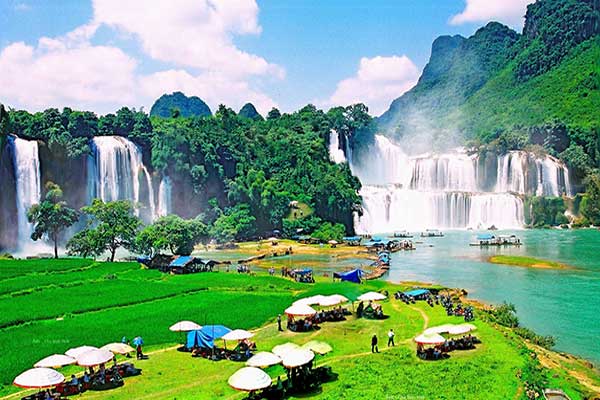
If you are a lover of exploring, you cannot ignore the “green pearl” of Northeast, which is Cao Bang. You should prepare for the journey to Cao Bang with useful tips that this travel guide about Northeast of Vietnam will share below. Cao Bang is an undeveloped place, so it has retained its original wilderness. Coming to Cao Bang, you will have a unique cultural experience. Cao Bang is divided into two distinct seasons: rainy season lasts from April to September and dry season is between October and March. There is a wide range of attractions that tourists can enjoy when traveling to Cao Bang, such as: Ban Gioc Waterfall – the most beautiful and majestic waterfall of Vietnam; the temple of Truc Lam Ban Gioc Buddha; Nguom Ngao Cave; Thang Hen Lake and Pac Bo Historical Site – the historical relic of national revolution of Vietnam.
4) Ha Giang

Ha Giang is located 300 km from Hanoi capital, which is the land of rocky terrain being famous for the majestic scenery in the North. In this travel guide about Northeast of Vietnam, we will offer the highlights of Ha Giang, so that you can find the most suitable destinations.
Coming to Ha Giang, tourists will watch majestic Hoang Su Phi rice terraced fields or a valley of buckwheat flowers, pass through the dangerous but also very poetic Ma Pi Leng pass, and feel a peaceful and ancient life at Dong Van ancient town. The most elegant tourist spots in Ha Giang are scattered along the road from Ha Giang City to Dong Van, below are the most beautiful tourist attractions you should not miss during your journey to explore Ha Giang.
The first place is Milestone Km 0, and the next destination is Bac Sum Slope – the slope of the highest mountain in Ha Giang, connecting Minh Tan commune, Vi Xuyen district and Quyet Tien commune, Quan Ba district. Then, tourists may visit Quan Ba Twin Mountain situated in the southwest of Dong Van Karst Plateau Geopark. After that, travelers should not miss to come to Yen Minh pine forest, Tham Ma slope and Sung La Valley, which is known as a paradise of highland flowers.
Additionally, King Cat’s Mansion might be an amazing place that tourists should visit. It not only contains historical stories but also possesses an attractive architecture. And definitely, you cannot ignore Lung Cu Flag tower – the most sacred tourist destination in Ha Giang.
In addition, one of the most popular attractions in Ha Giang is Dong Van Old Quarter, formed in the early 20th century, this destination is not only charming because of the time impression but also due to the unique design of Chinese people. Besides, tourists should spend time to admire Ma Pi Leng Pass and Hoang Su Phi, which are extremely amusing and attractive destinations.
5) Ba Be Lake
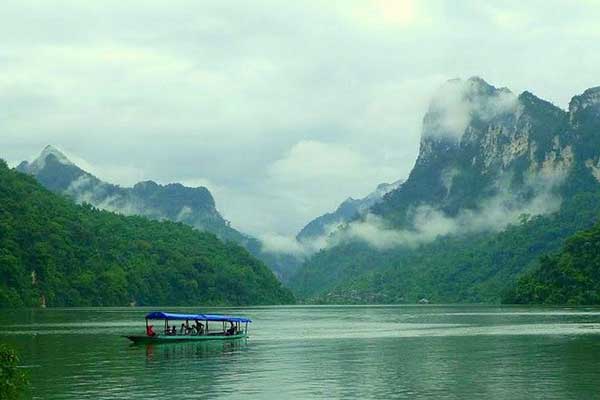
Ba Be Lake is one of the largest natural freshwater lakes in the North and it is ranked by UNESCO as one of the top 20 most beautiful freshwater lakes in the world to be protected and developed. This travel guide about Northeast of Vietnam will offer helpful information about Ba Be Lake for travelers. If you love natural sceneries and majestic mountains, then you should not miss your journey to Ba Be Lake.
Ba Be lake is a place having the harmony of mountains, rivers, water and cool climate, so visitors can visit this lake at any time of the year. However, the ideal time to visit Ba Be lake is in summer, early autumn or spring.
Surrounded by Ngan Son and Bac Son, Ba Be Lake is located in Ba Be National Park area, Nam Mau commune, Ba Be district, Bac Kan province. Its name originated from a story passed from generation to generation. As its name has implied, “Ba” means “Three” and Ba Be Lake is broken by three lakes: Pé Lam Lake, Pé Lu Lake and Pé Làng Lake. People in villages in Ba Be often grow corn, potatoes and cassava … These foods are often dried and hung in front of their house, this is a unique thing what makes visitors wanting to enjoy.
Coming to Ba Be lake, there is a wide variety of points of interest cannot be ignored. You can visit majestic Puong Cave with attractive stalactites; Dau Dang waterfall which is longer than 1000 m, contributing to the wild and romantic beauty of Ba Be. Furthermore, Hua Ma Cave which is about 6 km from Ba Be lake also have a lot of mysterious stalactites. Or you can go to Ao Tien (The Fairy Pond) and a cultural village, which is Pac Ngoi, in Nam Mau Commune, Bac Kan Province. In this village, there are more than 80 households with nearly 400 people.
In addition, you can visit many other places such as Phya Khao, Kim Hy, Fairy (Nang Tien) cave, Na Dang waterfall, Thac Gieng stream …
Here, you can choose from a broad range of tourist activities such as admiring spectacular landscapes on a canoe, visiting lakeside sceneries, trekking in primeval forests and riding a bike on winding roads. Smell of flowers in the air can help to soothe the soul of those who are traveling to Ba Be Lake.
In addition to exploring natural beauty, you also have opportunities to enjoy unique traditional food made from fish, shrimp, of local people from Ba Be Lake, hill chicken, vegetables, sticky rice and bamboo shoots.
6) Lang Son
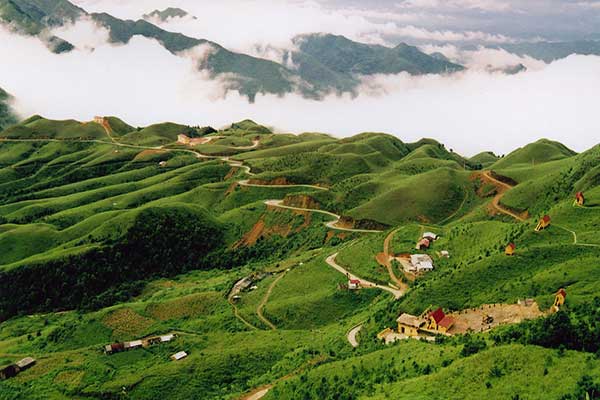
Lang Son is a city which is famous for its markets. Furthermore, it also attracts visitors by majestic and beautiful natural landscapes that nature has given to this land. This travel guide about Northeast of Vietnam will provide essential information so that you will have a meaningful and exciting trip to Lang Son.
Lang Son tourism in any season has its own unique features. Therefore, you should choose ideal time to suit your interests. If you want to relax and rest, you can go to Lang Son in summer. Or if you are fond of admiring white snow, then you should visit Lang Son in winter. However, if you want to explore unique cultural festivals of local people in Lang Son, then January is suitable time for your trip.
Some of the most popular sightseeing sites that you should not miss when visiting Lang Son are: Mau Son Mount – a place considered as the roof of North East that people want to be conquer and explore; Tam Thanh Grotto, which is not only famous for beautiful sceneries but also popular with a spiritual destination for Buddhists and visitors; Nhi Thanh Grotto, To Thi Mountain, Chi Lang Passage with terrestrial terrain, the Mac Dynasty, Phai Ve flag tower, Ky Cung temple – a relic of artistic architecture and folk beliefs, … and a wide range of markets.
















































































